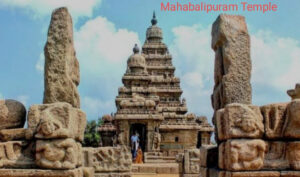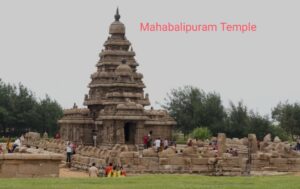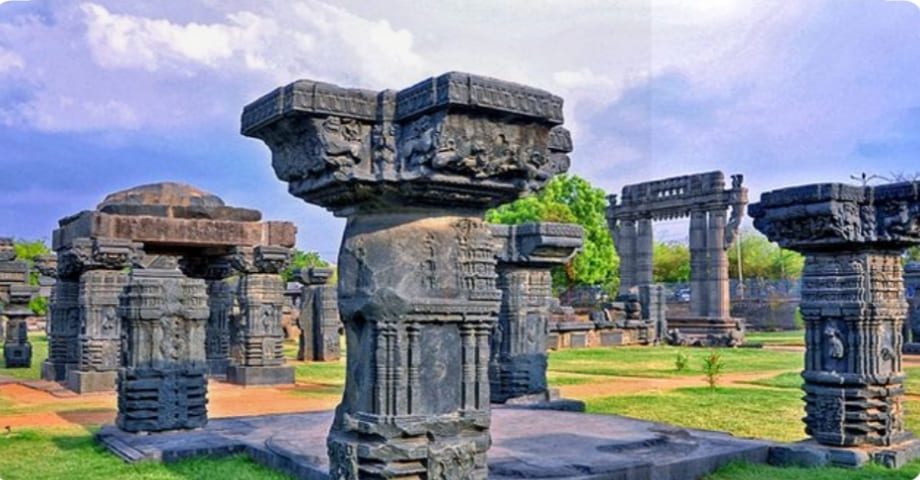Mahabalipuram Temple, an epitome of ancient Indian architecture and art, stands as a testament to the grandeur of the Pallava dynasty. Situated on the Coromandel Coast of the Bay of Bengal, this UNESCO World Heritage Site draws visitors from around the globe. This blog post delves into the historical, architectural, and cultural significance of Mahabalipuram Temple, offering a comprehensive guide for history enthusiasts and tourists alike.

1. Mahabalipuram Temple: Historical Background
The origins of Mahabalipuram, also known as Mamallapuram, trace back to the 7th century during the reign of the Pallava dynasty. This coastal town served as a bustling port city, showcasing the maritime prowess of the Pallavas. The temple complex, commissioned by King Narasimhavarman I, popularly known as Mam alla, highlights the zenith of Pallava architecture. Mahabalipuram’s historical significance lies in its role as a center of art, culture, and learning in ancient India.
2.Mahabalipuram Temple:Architectural Marvels
Mahabalipuram Temple is renowned for its architectural brilliance, epitomized by structures like the Shore Temple and Pancha Rathas.
• Shore Temple: Overlooking the Bay of Bengal, the Shore Temple is a magnificent structure built with granite blocks. It comprises three shrines dedicated to Lord Shiva and Lord Vishnu, showcasing the Pallava dynasty’s devotion to Hindu deities. The intricate carvings and sculptures adorning the temple walls depict various mythological tales and epitomize Dravidian architectural style.
• Pancha Rathas: These monolithic rock-cut structures represent the chariots (rathas) of the Pandavas from the Mahabharata. Each ratha is carved out of a single stone, reflecting the ingenuity of Pallava artisans. The detailed sculptures and ornate designs on the rathas offer a glimpse into the artistic excellence of that era.
Other notable structures include the Varaha Cave Temple, Krishna Mandapam, and the Descent of the Ganges, a colossal open-air rock relief. These architectural marvels collectively contribute to Mahabalipuram’s status as a treasure trove of ancient Indian art and architecture.
3. Cultural and Religious Significance
Mahabalipuram Temple holds immense cultural and religious significance. It serves as a major pilgrimage site for Hindus, drawing devotees who come to seek blessings and participate in rituals. The temple complex is steeped in mythological stories, adding to its spiritual allure.
One of the prominent legends associated with Mahabalipuram is the tale of Arjuna’s Penance. The intricate carvings on the Descent of the Ganges relief depict this story, highlighting Arjuna’s devotion and penance to obtain a powerful weapon from Lord Shiva. Such mythological narratives infuse the temple with a sense of divine reverence and historical depth.
Mahabalipuram also hosts annual festivals, such as the Mamallapuram Dance Festival, which celebrates classical Indian dance forms against the backdrop of these ancient structures. These cultural events reinforce the temple’s role as a living heritage site.

4. UNESCO World Heritage Site
In 1984, Mahabalipuram Temple was recognized as a UNESCO World Heritage Site, cementing its global significance. The site was selected based on criteria that highlight its exceptional architectural and artistic achievements. This recognition underscores the importance of preserving and conserving Mahabalipuram’s cultural heritage.
Efforts to protect the site include initiatives by the Archaeological Survey of India (ASI) to maintain the structural integrity and aesthetic beauty of the temples. Conservation programs focus on preventing erosion and damage caused by environmental factors, ensuring that future generations can witness the splendor of Mahabalipuram.
5. Visiting Mahabalipuram Temple
For those planning a visit to Mahabalipuram, the best time to explore this historic site is between November and February when the weather is pleasant. Mahabalipuram is easily accessible from Chennai, located about 60 kilometers away. Visitors can reach the town by road, rail, or air, with Chennai International Airport being the nearest airport.
While in Mahabalipuram, tourists can explore nearby attractions like the Mahabalipuram Beach, Tiger Cave, and the Crocodile Bank. Accommodations range from budget-friendly guesthouses to luxury resorts, catering to diverse preferences. The local cuisine, rich in seafood delicacies, offers a delightful culinary experience.
6. Modern Day Relevance
Mahabalipuram’s influence extends beyond its historical and cultural significance. The temple’s architectural style has inspired contemporary artists and architects, fostering a renewed interest in traditional Indian art forms. Additionally, Mahabalipuram plays a pivotal role in promoting tourism in Tamil Nadu, contributing to the local economy.
Community and governmental initiatives focus on sustainable development and heritage tourism. Efforts to raise awareness about the site’s historical importance aim to foster a sense of pride and responsibility among locals and visitors alike.
Conclusion:
Mahabalipuram Temple stands as a beacon of India’s rich cultural heritage, offering a glimpse into the architectural and artistic brilliance of the Pallava dynasty. Its historical, cultural, and religious significance continues to captivate visitors, making it a must-visit destination. As we celebrate and preserve Mahabalipuram’s legacy, we ensure that this magnificent heritage site remains an enduring symbol of India’s glorious past.
FAQ:
1.What is the Mahabalipuram Temple famous for?
2.Which God temple is in Mahabalipuram?
3.What to wear in Mahabalipuram?
4.Who built the seven Ratha temple of Mahabalipuram?
5.Mahabalipuram temple history
6.Mahabalipuram Temple in which state
7.Mahabalipuram temple built by
8.Mahabalipuram temple timings
9.Mahabalipuram temple photos
10.Mahabalipuram temple which God

